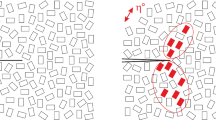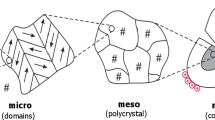Abstract
Ferroelectric perovskites are widely used in transducer, memory and optical applications due to their attractive electromechanical and optical properties. In these brittle materials, reliability and failure of devices is dominated by the behavior of cracks. The electromechanical coupling causes cracks to interact strongly with both mechanical as well as electrical fields. Additionally, cracks and domain patterns interact strongly with each other. Hence, an understanding of the electromechanics of cracks requires an accounting of all these interactions. In this work, we apply a real-space phase-field method to compute the stresses, domain patterns, and stray electric fields in the vicinity of a stationary crack, defined here as a geometric feature that causes large but bounded stress. We investigate the effects of charge compensation on the crack face, crack orientation with respect to the crystal lattice, and applied far-field stress and electric fields.
Similar content being viewed by others
References
Abdollahi A, Arias I (2011) Phase-field modeling of the coupled microstructure and fracture evolution in ferroelectric single crystals. Acta Mater 59(12): 4733–4746
Dayal K, Bhattacharya K (2007a) A real-space non-local phase-field model of ferroelectric domain patterns in complex geometries. Acta Mater 55(6): 1907–1917
Dayal K, Bhattacharya K (2007b) Active tuning of photonic device characteristics during operation by ferroelectric domain switching. J Appl Phys 102: 064102
El-Naggar MY, Dayal K, Goodwin DG, Bhattacharya K (2006) Graded ferroelectric capacitors with robust temperature characteristics. J Appl Phys 100: 114115
Fang D, Jiang Y, Li S, Sun CT (2007) Interactions between domain switching and crack propagation in poled batio3 single crystal under mechanical loading. Acta Mater 55(17): 5758–5767
Jiang Y, Zhang Y, Liu B, Fang D (2009) Study on crack propagation in ferroelectric single crystal under electric loading. Acta Mater 57(5): 1630–1638
Landis CM (2003) On the fracture toughness of ferroelastic materials. J Mech Phys Solids 51(8): 1347–1369
Landis CM (2004) Energetically consistent boundary conditions for electromechanical fracture. Int J Solids Struct 41: 6291–6315
Li LJ, Yang Y, Shu YC, Li JY (2010) Continuum theory and phase-field simulation of magnetoelectric effects in multiferroic bismuth ferrite. J Mech Phys Solids 58(10): 1613–1627
Li LJ, Lei CH, Shu YC, Li JY (2011) Phase-field simulation of magnetoelastic couplings in ferromagnetic shape memory alloys. Acta Mater 59(7): 2648–2655
Li W, Landis CM (2011) Nucleation and growth of domains near crack tips in single crystal ferroelectrics. Eng Fract Mech 78(7): 1505–1513
Lynch CS (1998) Fracture of ferroelectric and relaxor electro-ceramics: influence of electric field1. Acta Mater 46(2): 599–608
Schneider GA (2007) Influence of electric field and mechanical stresses on the fracture of ferroelectrics. Annu Rev Mater Res 37(1): 491
Schneider GA, Felten F, McMeeking RM (2003) The electrical potential difference across cracks in pzt measured by kelvin probe microscopy and the implications for fracture. Acta Mater 51(8): 2235–2241
Scott JF (2000) Ferroelectric memories. Springer, New York
Shu YC, Bhattacharya K (2001) Domain patterns and macroscopic behaviour of ferroelectric materials. Philos Mag Part B 81(12): 2021–2054
Sun X, Su YJ, Gao KW, Guo LQ, Qiao LJ, Chu WY, Zhang TY (2011) Surface potential distribution in an indentation-pre-cracked batio3 single crystal. J Am Ceram Soc 94(12): 4299–4304
Tagantsev AK, Sherman VO, Astafiev KF, Venkatesh J, Setter N (2003) Ferroelectric materials for microwave tunable applications. J Electroceram 11: 5–66
Uchino K (1996) Piezoelectric actuators and ultrasonic motors. Kluwer, Dordrecht
Wang J, Landis CM (2004) On the fracture toughness of ferroelectric ceramics with electric field applied parallel to the crack front. Acta Mater 52(12): 3435–3446
Wang J, Zhang TY (2007) Phase field simulations of polarization switching-induced toughening in ferroelectric ceramics. Acta Mater 55(7): 2465–2477
Westram I, Oates WS, Lupascu DC, Rodel J, Lynch CS (2007) Mechanism of electric fatigue crack growth in lead zirconate titanate. Acta Mater 55(1): 301–312
Xu BX, Schrade D, Gross D, Mueller R (2011) Fracture simulation of ferroelectrics based on the phase field continuum and a damage variable. Int J Fract 166(1): 163–172
Xu BX, Schrade D, Gross D, Mueller R (2010) Phase field simulation of domain structures in cracked ferroelectrics. Int J Fract 165(2): 163–173
Xu Y (1991) Ferroelectric materials and their applications. North-Holland
Yang L, Dayal K (2010) Formulation of phase-field energies for microstructure in complex crystal structures. Appl Phys Lett 96: 081916
Yang L, Dayal K (2011a) A completely iterative method for the infinite domain electrostatic problem with nonlinear dielectric media. J Comput Phys 230(21): 7821–7829
Yang L, Dayal K (2011b) Effect of lattice orientation, surface modulation, and applied fields on free-surface domain microstructure in ferroelectrics. Acta Mater 59(17): 6594–6603
Zhang W, Bhattacharya K (2005) A computational model of ferroelectric domains. Part I: model formulation and domain switching. Acta Mater 53(1): 185–198
Author information
Authors and Affiliations
Corresponding author
Rights and permissions
About this article
Cite this article
Yang, L., Dayal, K. Microstructure and stray electric fields at surface cracks in ferroelectrics. Int J Fract 174, 17–27 (2012). https://doi.org/10.1007/s10704-011-9670-2
Received:
Accepted:
Published:
Issue Date:
DOI: https://doi.org/10.1007/s10704-011-9670-2




